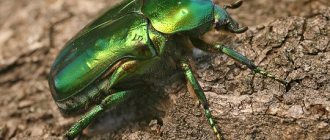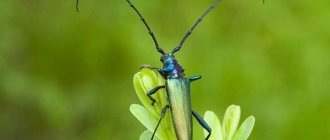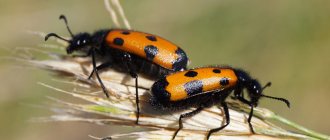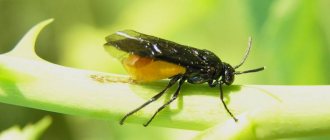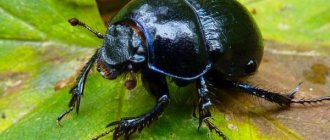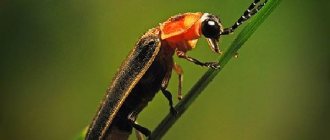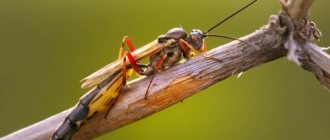- Wild animals
- >>
- Insects
The dung beetle , a member of the Lamelidae family and the subfamily Scarabaeidae, also called the dung beetle, is an insect that forms dung into a ball using its paddle head and paddle-shaped antennae. In some species the ball can be the size of an apple. At the beginning of summer, the dung beetle buries itself in the ball and feeds on it. Later in the season, the female lays eggs in dung balls, which the larvae then feed on.
Origin of the species and description
Photo: Dung beetle
Dung beetles evolved at least 65 million years ago as dinosaurs declined and mammals (and their droppings) grew larger. There are about 6,000 species worldwide, concentrated in the tropics, where they feed primarily on the dung of terrestrial vertebrates.
The sacred scarab of ancient Egypt (Scarabaeus sacer), found in many paintings and jewelry, is a dung beetle. In Egyptian cosmogony there is a scarab beetle rolling a ball of dung and a ball representing the Earth and the Sun. Six branches, each with five segments (30 in total), represent the 30 days of each month (in fact, this species only has four segments on its feet, but closely related species have five segments).
Video: Dung beetle
An interesting member of this subfamily is Aulacopris maximus, one of the largest species of dung beetles found in Australia, reaching a length of 28 mm.
Interesting fact: Indian scarabs Heliocopris and some Catharsius species make very large dung balls and cover them with a layer of clay, which becomes dry; they were once thought to be old stone cannonballs.
Members of other scarab subfamilies (Aphodiinae and Geotrupinae) are also called dung beetles. However, instead of forming balls, they dig a chamber under a pile of dung, which is used during feeding or to store eggs. Aphodian beetle droppings are small (4 to 6 mm) and typically black with yellow spots.
The Geotrupes dung beetle is approximately 14 to 20 mm in length and is brown or black in color. Geotrupes stercorarius, known as the common dung beetle, is a common European dung beetle.
Ecological significance
The dung beetle is used on dairy farms and cattle ranches to solve the problem of animal manure disposal.
When insects use manure to raise their young, they minimize the number of places where insects and bacteria harmful to humans and animals can thrive.
This is especially true for flies, which do not shy away from even one pile of manure and can fly into the house and land on food. In turn, they provide the soil with organic matter, which improves its fertility.
Appearance and features
Photo: What a dung beetle looks like
Dung beetles are usually round with short wings (elytra) that expose the end of the abdomen. They vary in size from 5 to 30 mm and are usually dark in color, although some have a metallic sheen. In many species, the males have a long, curved horn on their head. Dung beetles can eat more than their weight in 24 hours and are considered beneficial to humans because they speed up the process of converting dung into substances used by other organisms.
Dung beetles have impressive "weapons", large horn-like structures on the head or thorax, which males use to fight. They have spurs on their hind legs that help them roll dung balls, and their strong front legs are good for both wrestling and digging.
Most dung beetles are strong fliers, with long flight wings folded under hardened outer wings (elytra), and can travel several kilometers in search of the perfect dung. Using special antennas, they can smell manure from the air.
Even a small ball of fresh dung can be pushed up to 50 times the weight of a particular dung beetle. Dung beetles require exceptional strength, not only to push dung pellets but also to fend off male competitors.
Fun fact: The individual strength record goes to the dung beetle Onthphagus taurus, which can withstand a load equivalent to 1,141 times its own body weight. How does this relate to human feats of strength? It would be like a man pulling 80 tons.
Where does the dung beetle live?
Photo: Dung beetle in Russia
The widespread family of dung beetles (Geotrupidae) contains more than 250 different species that are distributed throughout the globe. About 59 species live in Europe. Dung beetles mainly live in forests, fields and meadows. They avoid climates that are too dry or too wet, so they can be found in subtropical and temperate climate zones.
Dung beetles are found on every continent except Antarctica.
They also live in the following places:
- farmland;
- forests;
- meadows;
- prairies;
- in desert habitats.
They are most often found in deep caves, feeding on copious amounts of bat dung and in turn preying on other giant invertebrates that roam the dark passages and walls.
Most dung beetles use the dung of herbivores, which do not digest food well. Their manure contains semi-digested grass and a smelly liquid. It is this liquid that adult beetles feed on. Some of them have special mouthpieces designed to suck out this nutritious soup, which is full of microorganisms that the bugs can digest.
Some species feed on carnivore dung, while others skip it and instead eat mushrooms, carrion, and decaying leaves and fruits. The shelf life of manure is very important for dung beetles. If the manure has been sitting around long enough to dry out, the beetles cannot suck out the nutrition they need. One study in South Africa found that dung beetles lay more eggs during the rainy season, when they contain more moisture.
Role in nature
A very interesting and instructive story is connected with dung beetles. During the period of exploration of the Australian continent by European colonists, as is known, a variety of livestock, which had never lived in Australia before, were brought there. Sheep are the most widespread species here. The wool sent to England yielded fabulous profits, and therefore the flocks of sheep grew rapidly. However, farmers soon began to notice the depletion of pastures. The once thick and lush green grass stands degenerated into meager bushes of semi-dry grasses, on which the sheep did not gain the necessary weight, as before.
The experts involved in solving the problem solved the mystery: it turned out that all the local pastures had become covered with a dense layer of sheep manure over many years of grazing. There was simply no one here to process it. Among Australian insects there were no dung beetles that would consider sheep waste worthy food for themselves. As a result, plants had difficulty breaking through the dried manure shell. This problem had to be solved somehow.
For this purpose, entomological specialists were involved. They quickly found a way out of an unpleasant situation. Expeditions were sent to Europe, whose participants were tasked with finding dung beetles, for which sheep manure was their favorite food.
It should be noted that by that time the Australians had already been repeatedly frightened by ill-conceived imports (introductions) of foreign plants and animals (it is enough to recall the catastrophic reproduction here of American species of prickly pear cacti, and later of rabbits). And dung beetles, as we already know, are often accompanied by completely foreign creatures, for example, parasitic gamas mites. It was these, in particular, that Australian entomologists were afraid of accidentally introducing. It is unknown how these parasites would behave if they moved to local Australian dung beetles.
To ensure that new species of dung beetles do not introduce any harmful organisms that accompany them to the continent, this time all precautions were taken. A special intermediate laboratory was organized in South Africa, where beetles caught in Europe were comprehensively examined and studied over several generations.
About 50 species of dung beetles were subjected to such a comprehensive check.
Finally, the species that turned out to be the most promising for solving the problem were transported to Australia and released into the wild. As entomologists predicted, finding themselves among the “ocean” of their favorite food, the “settlers” began to multiply rapidly, literally following on the heels of the sheep. As a result, as strange as it may sound, dung beetles helped solve a major national economic problem.
What does the dung beetle eat?
Photo: Insect dung beetle
Dung beetles are coprophagous insects, meaning they eat the excrement of other organisms. Although not all dung beetles feed exclusively on dung, they all do so at some point in their lives.
Most prefer to feed on grass dung, which is largely undigested plant matter, rather than carnivore waste, which has very little nutritional value for insects.
Recent research from the University of Nebraska suggests that dung beetles are most attracted to omnivorous droppings because they provide both nutritional value and the right amount of scent to make it easy to find. They are fussy eaters, selecting large pieces of dung and breaking them down into tiny particles, ranging in size from 2-70 microns (1 micron = 1/1000 of a millimeter).
Fun Fact: All organisms require nitrogen to build proteins such as muscles. Dung beetles get them from manure. By eating it, dung beetles can take cells from the intestinal wall of the herbivore that produced it. It is a protein-rich source of nitrogen.
Recent research suggests that obesity and diabetes in humans may be linked to our individual gut microbiomes. Dung beetles can use their gut microbiome to help them digest complex components of dung.
Soil nurse
The dung beetle is a hardy little worker whose homeland is considered to be Africa. People have formed an ambiguous attitude towards it: some consider it a dangerous pest, others consider it a helper and benefactor in agriculture. Scientists include 750 species of beetles as dung beetles. The most typical species for our area is the common dung beetle, which is listed in the Red Book of the Belgorod Region as a declining species.
The dung beetle feeds on organic matter, and primarily on the excrement of large herbivores. Where these beetles are absent, grass does not grow, since manure does not decompose. Oddly enough, they are real picky eaters. Before starting to process the manure, the beetles sniff at it for a long time, study it with the help of their antennae, and if the smell of the waste does not suit them, then they move on to look for something more suitable.
Dung is not the only thing these beetles feed on. Adults can also eat some mushrooms or carrion.
This orderly, finding a pile of manure, forms balls from it and rolls them into his shelter holes. Moving its forelimbs, the beetle moves forward, carrying the ball behind it, like a wheelbarrow. At home, larvae are waiting for this food - white fat ones with short legs and strong jaws.
Features of character and lifestyle
Photo: Ball of dung beetle
Scientists group dung beetles according to how they make their living:
- rollers form a little manure into a lump, roll it away and bury it. The balls they make are used either by the female to lay eggs (called a fuzzy ball) or as food for the adults;
- tunnellers land on a patch of dung and simply dig into the patch, burying some of the dung;
- the inhabitants are content to remain on top of the dung to lay their eggs and raise their young.
Fights between rollers, which take place on the surface and often involve more than just two beetles, are chaotic fights with unpredictable consequences. The biggest doesn't always win. Therefore, investing energy in growing body weapons such as antlers would not be beneficial for the rollers.
Interesting fact: 90% of dung beetles dig tunnels directly under the dung and make an underground nest of brood balls in which they lay their eggs. You'll never see them unless you're willing to dig through the dung.
On the other hand, rollers transport their prize on the soil surface. They use celestial signals such as the sun or moon to stay away from competitors who might steal their marble. On a hot day in the Kalahari, the soil surface can reach 60°C, which is death for any animal that cannot control its body temperature.
Dung beetles are small, as is their thermal inertia. Consequently, they heat up very quickly. To avoid overheating as they roll their balls under the scorching midday sun, they climb to the top of the ball to cool off for a moment before briskly striding across the sand in search of shade. This allows them to roll further before returning to the ball.
Now you know how the dung beetle rolls a ball. Let's see how this insect reproduces.
Other names, mythical notes
In Ancient Egypt, the divine creature was the scarab beetle. His image is present on the walls of tombs, jewelry made of gold, silver, and stones. Talismans are made with the scarab beetle, which give confidence to their owner, courage, strength, courage, and wisdom. They are a source of health, family well-being, and hard work.
Interesting!
The beetle owes its life activity to being elevated to “sainthood.” At night, he rolls balls of dung, just as the sun revolves around the earth. The ancient Egyptians saw a mystical connection in this and began to venerate the sacred beetle. Legends are made about it; insects are present in historical films about tombs. However, many do not realize that the dung beetle and the scarab are one and the same.
In total, there are about 600 species of dung beetles, 20 of them live in Russia. Other names are driller, digger, cleaner.
Social structure and reproduction
Photo: Scarab dung beetle
Most dung beetle species breed during the warmer months of spring, summer, and fall. When dung beetles move or roll away dung, they do so primarily to feed their young. Dung beetle nests are equipped with food, and the female usually places each individual egg in her tiny dung sausage. When the larvae emerge, they are well supplied with food, allowing them to complete their development in a safe environment.
The larvae will undergo three skin changes to reach the pupal stage. Male larvae develop into major or minor males depending on how much dung is available to them during their larval phases.
Some dung beetle larvae are able to survive unfavorable conditions such as drought by stopping development and remaining inactive for several months. The pupae develop into adult dung beetles, which burst out of the dung ball and scoop them to the surface. The newly formed adults will fly to a new bed of dung, and the whole process begins again.
Dung beetles are one of the few groups of insects that exhibit parental care for their young. In most cases, child-rearing responsibilities rest with the mother, who builds the nest and provides food for her children. But in some species, both parents share childcare responsibilities to some extent. In the dung beetles Copris and Ontophagus, the male and female work together to dig their nests. Certain dung beetles even mate once for life.
Habitat
Dung beetles try not to retire, but live in certain groups, creating their “homes” below ground level. These insects are most active in the dark. The beetles feed on manure, which is how they got their common name. They are also capable of killing smaller insects, so they are very useful in this regard. It is noteworthy, but it has been established that adult individuals can even feed on pathogenic fungi that form in manure. Although it should be noted that it will not be particularly difficult for dung beetles to do without food at all.
Natural enemies of dung beetles
Photo: What a dung beetle looks like
Several reviews of the behavior and ecology of the dung beetle (Coleoptera: Scarabaeidae), as well as numerous research reports, either implicitly or explicitly indicate that predation on dung beetles is rare or absent and therefore of minimal or no importance to the biology of the group .
This review presents 610 records of dung beetle predation from 409 species of birds, mammals, reptiles and amphibians from around the world. The involvement of invertebrates as predators of dung beetles has also been documented. It is concluded that these data establish predation as a potentially important factor in the evolution and modern behavior and ecology of dung beetles. The data presented also represent a significant underestimation of predation within the group.
Dung beetles also fight with their fellows for dung pellets, which they make to feed on and/or serve as sex objects. Elevated chest temperature plays a critical role in these competitions. The more a beetle shivers to keep warm, the higher the temperature of the paw muscles adjacent to the flying muscles in the thorax, and the faster its paws can move to ball up droppings and roll them away.
Endothermy thus aids in the fight for food and reduces the duration of contact with predators. Additionally, hot beetles have an advantage when competing for dung balls made by other beetles; in battles for dung balls, hot beetles almost always win, often despite a large size disadvantage.
Links[edit]
- "Some lesser-known fascinating facts about dung beetles". IANS
. news.biharprabha.com. Retrieved April 21, 2014. - ^ ab Griffiths, Hannah M.; Louzada, Julio; Bardgett, Richard D.; Barlow, Jos (2016-03-03). "Assessing the importance of intraspecific variation in functional traits of dung beetles". PLOS ONE
.
11
(3): e0145598. Bibcode: 2016PLoSO..1145598G. DOI: 10.1371/journal.pone.0145598. ISSN 1932-6203. PMC 4777568. PMID 26939121. - Frolov A.V. "Subfamily Scarabaeinae: Atlas of Tribal Representatives (Scarabaeidae)". Retrieved August 2, 2007.
- ↑
Jonathan Amos (January 24, 2013).
"Dung beetles navigating the Milky Way". BBC News
. Retrieved January 28, 2013. - Dacke, M.; Baird, E.; Byrne, M.; Scholtz, CH; Warrant, E. J. (2013). "Dung beetles use the Milky Way for orientation". Current Biology
.
23
(4): 298–300. DOI: 10.1016/j.cub.2012.12.034. PMID 23352694. - "Geotrupidae (ground dung beetles)". kerbtier.de. Retrieved March 28, 2015.
- "Scarabaeinae dung beetles". Archived from the original on 2015-03-19. Retrieved March 28, 2015.
- Skelly, P.E. Aphodiinae. A general guide to New World scarab beetles.
University of Nebraska State Museum. 2008 version - França, Filipe M.; Korasaki, Vaneska; Louzada, Julio; Vaz de Mello, Fernando Z. (2016). "First report of dung beetles in the Amazon savannas of Roraima, Brazil". Biota Neotropica
.
16
(1). DOI: 10.1590/1676-0611-BN-2015-0034. ISSN 1676-0603. - Beyrose, Wallace; Slade, Eleanor M.; Barlow, Jos.; Silveira, Juliana M.; Louzada, Julio; Sayer, Emma (2017-01-01). "Dynamics of dung beetle communities in intact tropical forests: implications for ecological assessment of land-use change" (PDF). Insect Conservation and Diversity
.
10
(1):94–106. DOI: 10.1111/icad.12206. ISSN 1752-4598. S2CID 88666069. - Dell'Amore, Christina. "Favorite foods of dung beetles revealed". National Geographic
. National Geographic Society. Archived from the original on 2016-09-23. Retrieved September 22, 2016. - Khaleeli, Homa (24 March 2010). “How strong is a dung beetle?” . The keeper
. London. - Before 2013, page 123.
- Dacke, M.; Nilsson, DE; Scholtz, CH; Byrne, M.; Warrant, E. J. (2003). "Animal Behavior: Insect Orientation to Polarized Moonlight." Nature
.
424
(6944): 33. Bibcode: 2003Natur.424...33D. DOI: 10.1038/424033a. PMID 12840748. S2CID 52859195. - Jump up
↑ Milius, Susan (2003).
"Moonlight: Beetles navigate by the polarity of the Moon". Science News
.
164
(1):4–5. DOI: 10.2307/3981988. JSTOR 3981988. - Roach, John (2003). "Dung Beetles Move on Moon, Study Says", National Geographic News
. Retrieved August 2, 2007. - Milius, S. (2003). “Part-time job.” Science News
.
164
(1):4–5. DOI: 10.2307/3981988. JSTOR 3981988. - ^ ab Duck, Marie; Baird, Emily; Byrne, Marcus; Scholtz, Clarke H.; Warrant, Eric J. (2013). "Dung beetles use the Milky Way for orientation". Current Biology
.
23
(4): 298. DOI: 10.1016/j.cub.2012.12.034. PMID 23352694. - Wits University (24 January 2013). "Dung Beetles Follow the Milky Way: Insects Using the Stars for Orientation". ScienceDaily
. Retrieved January 25, 2013. - Meyer-Rohey, W. B. (1978). "Retina and dioptric apparatus of the dung beetle (Euoniticellus africanus; Scarabaeidae)". Journal of Insect Physiology
.
24
(2): 165–179. DOI: 10.1016/0022-1910 (78) 90114-2. - Meyer-Rokhov, V.B.; Gokan, N. (1990). "Eye of the dung beetle Onthophagus posticus (Coleoptera, Scarabaeidae)". New Zealand Journal of Entomology
.
13
: 7–15. DOI: 10.1080/00779962.1990.9722582. - Fabre, J. Henri (1949). The world of insects by J. Henri Fabre. De Mattos, Alexandre Teixeira (translator). Dodd, Mead and company. paragraph 99. I ask myself in vain that Proudhon introduced into scarab morality the bold paradox that “property means robbery,” or what diplomat taught the dung beetle the wild maxim that “might is right.”
- França, F.M.; Benquitt, C.E.; Peralta, G; Robinson, J.P.W.; Graham, N. A. J.; Tilianakis, J.M.; Berenguer, E; Lees, A.C.; Ferreira, J; Louzada, J; Barlow, J (2020). "Interaction of climate and local stressors threatens tropical forests and coral reefs". Philosophical Transactions of the Royal Society
B.
375
(1794): 20190116. DOI: 10.1098/rstb.2019.0116. PMC 7017775. PMID 31983328. - França, Filipe; Ferreira, J; Vaz de Mello, FZ; Maya, L.F.; Berenguer, E; Palmeira, A; Fadini, R. Louzada, J; Braga, R; Oliveira, V. H.; Barlow, J. (February 10, 2022). "El Niño impacts on human-modified tropical forests: implications for dung beetle diversity and associated ecological processes". Biotropica
.
52
(1):252–262. DOI: 10.1111/btp.12756. - França, Filipe; Louzada, Julio; Korasaki, Vaneska; Griffiths, Hannah; Silveira, Juliana; Barlow, Jos (2016). “Do interim estimates underestimate the impact of logging on tropical biodiversity? An example from the Amazon using dung beetles". Journal of Applied Ecology
.
53
(4):1098–1105. DOI: 10.1111/1365-2664.12657. - França, Filipe; Barlow, Jos.; Araujo, Barbara; Louzada, Julio (November 4, 2016). “Does selective logging stress tropical forest invertebrates? Using fat deposits to study the sublethal response of dung beetles". Ecology and evolution
.
6
(23):8526–8533. DOI: 10.1002/ece3.2488. PMC 5167030. PMID 28031804. - França, Filipe M.; Frazão, Fabio S.; Korasaki, Vaneska; Louzada, Julio; Barlow, Jos (2017-12-01). "Identifying logging intensity thresholds in dung beetle communities to improve sustainable management of the Amazon rainforest" (PDF). Biological conservation
.
216
(Suppl C): 115–122. DOI: 10.1016/j.biocon.2017.10.014. - França, Filipe; Ferreira, J; Vaz de Mello, FZ; Maya, L.F.; Berenguer, E; Palmeira, A; Fadini, R. Louzada, J; Braga, R; Oliveira, V. H.; Barlow, J. (February 10, 2022). "El Niño impacts on human-modified tropical forests: implications for dung beetle diversity and associated ecological processes". Biotropica
.
52
(1):252–262. DOI: 10.1111/btp.12756. - Brown, J.; Scholtz, CH; Janeau, J. L.; Grellier, S.; Podvoevsky, P. (2010). "Dung beetles (Coleoptera: Scarabaeidae) can improve soil hydrological properties" (PDF). Applied Soil Ecology
.
46
: 9–16. DOI: 10.1016/j.apsoil.2010.05.010. hdl: 2263/14419. - Nichols, E.; Spector, S.; Louzada, J.; Larsen, T.; Amezquita, S.; Favila, M. E. (2008). "Ecological functions and ecosystem services provided by Scarabaeinae dung beetles." Biological conservation
.
141
(6):1461–1474. DOI: 10.1016/j.biocon.2008.04.011. - Badenhorst, J.; Dabrowski, J.; Scholtz, CH; Truter, W. F. (2018). “Dung beetle activity improves herbaceous plant growth and soil properties under constraints simulating the reclamation of mined land in South Africa.” Applied Soil Ecology
.
132
: 53–59. DOI: 10.1016/j.apsoil.2018.08.011. HDL: 2263/67268. - Griffiths, Hannah M.; Bardgett, Richard D.; Louzada, Julio; Barlow, Jos (2016-12-14). "The importance of trophic interactions for ecosystem function: dung beetle communities influence seed burial and seedling growth in tropical forests". Proc.
R. Soc. B. _
283
(1844):20161634. doi:10.1098/rspb.2016.1634. ISSN 0962-8452. PMC 5204146. PMID 27928036. - Losey, J. E.; Vaughan, M. (2006). "The Economic Value of Ecological Services Provided by Insects" (PDF). Bioscience
.
56
(4): 311–23. DOI: 10.1641/0006-3568 (2006) 56[311]: TEVOES 2.0.CO; 2. Archived from the original (PDF) on 2018-06-19. Retrieved January 28, 2009. - Jump up
↑ Bornemissza, G. F. (1976).
"Australian dung beetle 1965–1975". Australian Meat Research Committee Review
.
30
: 1–30. - "Application Summary - ERMA200599" (PDF). ERMA. Retrieved December 12, 2010. [ permanent dead link
] - Ihaka, James (24 September 2010). "Let's roll...a dung beetle to fight global warming". The New Zealand Herald
. Retrieved December 12, 2010. - August 17, 2014, 01:09 (05/07/2012). "Experts fell dung beetle". fwplus.co.nz. Archived from the original on 2013-04-14. Retrieved August 16, 2014.
- Guilford, Grant (2013-02-18). "Grant Guilford: The dung beetle is plotting a risky game". NZ Herald
. www.nzherald.co.nz. Retrieved August 16, 2014. - drj9 (March 17, 2013). "'Fickle Thy name' Vox Populi: puzzling over dung beetles and science reporting". A Journal of Outrageous Speculation
. Retrieved April 22, 2014. - “Release Program | Dung beetles in New Zealand". Dungbeetle.org.nz. 2013-09-26. Retrieved April 22, 2014.
- Jump up
↑ Ferrer-Paris, José R. (2014).
"El escarabajo estercolero africano, Digitonthophagus gazella , (Coleoptera: Scarabaeidae) en la región Neotropical, ¿beneficioso o perjudicial?" . Boletín de la Red Latinoamericana Para el Estudio de Especies Invasoras
.
4
(1):41–48. - ↑
Daly, John (18 October 2022).
"Stool-eating beetles and charcoal used by Western Australian farmers to combat climate change". ABC.net.au.
_ Australian Broadcasting Corporation. Retrieved October 18, 2022. Mr Pou said his innovative farming system could help livestock farmers become more profitable while helping to tackle the impacts of climate change. - "Isis and Osiris", Moralia
, in Volume V of the Loeb Classical Library, 1936, now in the public domain. Retrieved August 2, 2007. - Andrews, Carol (1994). Amulets of Ancient Egypt
. Texas: University of Texas Press. ISBN 0-292-70464-X. paragraph 51. - Meyer-Rohi, V.B. (January 2017). "Medicinal arthropods and other invertebrates, mostly terrestrial, important in folk medicine: a comparative overview and overview". Journal of Ethnobiology and Ethnomedicine
.
13
(9): 9. DOI: 10.1186/s13002-017-0136-0. PMC 5296966. PMID 28173820. - Andersen, Hans Christian; James, M. R. (trans.) (1930). Bug . Hans Andersen Forty-Two Stories
. Faber and Faber.

